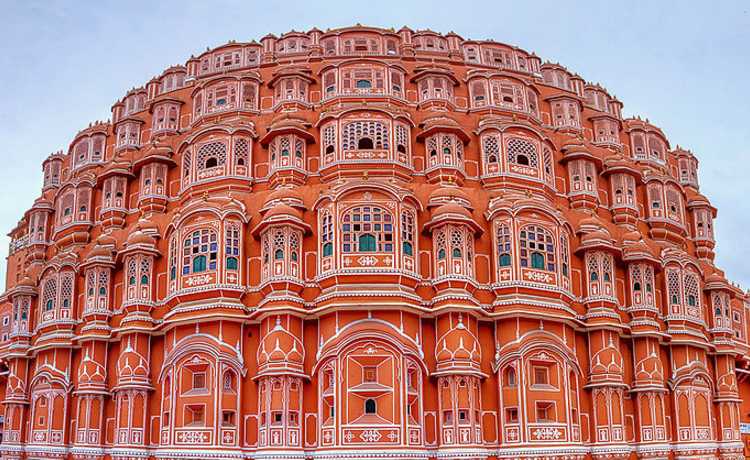
Jaipur, the desert capital of India, popularly known as the Pink City is the land of palaces, lakes, maharajas, alluring architecture.
History of Jaipur
The foundation of the city dates back to 1727. The city was founded by Maharaja Sawai Jai Singh II, a Kachwaha Rajput, who ruled Jaipur between the years 1699 and 1743. Earlier, the capital was located at Amber some 11 kilometers away; however, an increasing population and scarcity of water led to the king transferring the capital to Jaipur. It is believed that Jaipur is the first planned city of the country. The king took the help of Vidyadhar Bhattacharya to build Jaipur. Bhattacharya was a Brahmin scholar from Bengal well-versed in the disciplines of science and mathematics. The origin of the name Pink City goes back to 1878 when the Prince of Wales paid a visit to the city. To welcome the prince, the city was painted in pink color and hence came to be called the Pink City.
Places of Tourist Interest in Jaipur
Hawa Mahal
Hawa Mahal or Palace of the Winds, or also called Palace of the Breeze, is one of the important places to visit in Jaipur. Built by Maharaja Sawai Pratap Singh in 1798, Hawa Mahal is a five-storey extension in the form of a honeycomb. This unique building has 953 small windows, called jharokas, decorated with intricate lattice work. The entire palace represents the crown of the Hindu God, Lord Krishna.
Even though this palace was built during ancient times, it reflects the scientific vision of Maharaja Sawai Pratap Singh in a distinct way. The windows of this palace have been designed in such a way that irrespective of the time or season of the year, cool breeze always persists inside the palace. Due to this reason, Hawa Mahal was the favourite summer holiday destination of the Rajput family and is today a popular place to visit in Jaipur.

City Palace
The magnificent City Palace in Jaipur is one of the most famous tourist attractions in the city. Built by Maharaja Sawai Jai Singh during the years 1729 to 1732, the vast complex of the palace occupied one-seventh of the walled city. In fact, it was once the seat of the Maharaja of Jaipur. Planned with precise intricacies, the palace is divided into a series of courtyards, buildings and gardens including the Chandra Mahal and the Mubarak Mahal. The museum showcases various unique handcrafted products and other things that belong to the royal heritage of the City Palace. The historical structure is located in the old part of Jaipur city and can be easily located and reached by any means of transport.
The architecture of the City Palace will strike a sense of awe in you from the very beginning. The facade itself is designed with acute and detailed handiwork and showcases a blend of Mughal and Rajput architecture styles. The outer wall was built by Jai Singh II, however, the palace itself has been subjected to various changes over the course of time, with some of them even belonging to the early 20th century. The City Palace has three gates, out of which the Virendra Pol and Udai Pol are open to the public.

Jantar Mantar Observatory
Jantar Mantar, built by King Jai Singh II between 1727 and 1734, literally means "calculation instrument". More than just a curious collection of sculptures, each structure at the intriguing Jantar ,Mantar observatory has a specialized astronomical function. There are 14 structures in total, which measure time, predict eclipses, and track stars. The most impressive one is the huge Samrat Yantra sundial. At a height of 90 feet (27 meters), it has a shadow that moves roughly the width of a person's hand every minute. It's a profound display of how quickly time does in fact go!
This is one of the oldest museums in all of Rajasthan which is also the state museum. It’s a perfect spot to enjoy at night on your list of places to visit in Jaipur in one day and it oozes in colours showcasing pride in the pink city.
Achrol Fort
An adventure day out is in treasure box right here when one decides to reach Achrol and trek the replete of architectural marvels and forts, located at the very outskirt of the city. Not just trekking, another added activity i.e. rappelling is on the way in a beautiful morning. Enjoy the view of old remnants of the fort and relish the nature around.
The other palaces you should visit in Jaipur are: Visit Nahargarh Fort , Bazaars of Jaipur, Safari in Jhalana Leopard Conservation Reserve, Visit Water Valley, Visit Jal Mahal, Visit Chour Ghati, visit Jaigarh Fort, Bhuteshwar Nath Mahadev, Visit Achrol Fort, Galtaji or Galta Monkey Temple, Abhaneri Step Well, Rambagh Palace, Central Park, Romantic Candle Light Dinner On Sand Dunes in Jaipur, Camping at Sambhar Lake, Elephant Safari in Amer Fort, Visits to the Forts of Jaipur

Comments